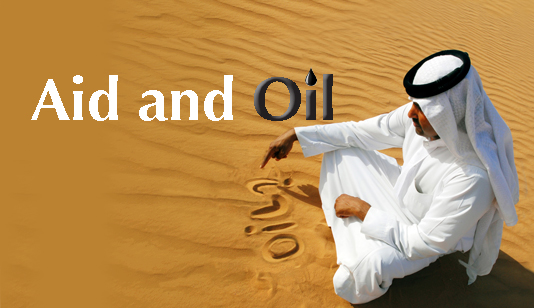Aid and Oil
Can foreign aid still play an important role in developing economies that discover oil? And how does the current oil price crash affect this phenomenon?
Oil and its derivative forms have many uses that are very much part of our daily lives – from the fuel that allows us to travel, the materials we wear, the heat and light for our dwellings, coverings for the roads, and even the cosmetics, medicines and additives in the food we eat. But it also has less salubrious uses – it can be the reason that nations go to war and the source of wealth that funds terrorism.
The following two articles, ‹Aid and Oil› and ‹The Oil Shock›, include reports by the IMF and other organisations that provide an array of factors, both financial and social, that are affected by the current fall in price.
What’s happening to oil prices and supply levels?
There’s no way of avoiding coverage of the recent price crash, with crude oil losing nearly 60% of its value since last summer. Crude now sells in the region of $49 a barrel, down from $115 in June 2014, and this reduction is starting to make a difference for families running cars, or using oil and gas to warm their houses during winter.
The Wall Street Journal reported on 4 February that supplies were approaching an 80-year high in the US, with economists the world over looking at the global implications of failures by the Organization of the Petroleum Exporting Countries (OPEC) to curb supply in the Middle East and elsewhere.
This need for action – that is to say a reduction in production/supply levels until demand increases – is all too apparent. Let’s take the International Energy Agency’s Oil Market Report of January 2015 summary into consideration:
The price of oil continued to collapse into January as rising supplies collided with weak demand growth and OPEC maintained its commitment to not cut production. Brent crude futures last traded at $48.40/barrel, near a six-year low.
Macroeconomic weakness continues to restrain global oil demand growth, with 4Q14 deliveries estimated just 0.6 million barrels per day (mb/d) above year-earlier levels. Despite lower prices, demand growth is only forecast to accelerate to 0.9 mb/d in 2015, unchanged since last month’s Report.
OPEC output rose by 80 thousand barrels per day (kb/d) in December to 30.48 mb/d, as Iraqi supply surged to 35-year highs, offsetting deeper losses in Libya. Downward revisions to the non-OPEC supply outlook raise the ‘call’ on OPEC for 2H15 to an average 29.8 mb/d – just shy of OPEC’s official target of 30 mb/d.
Global refinery crude throughputs surged to a new record high of 78.9 mb/d in December, lifting the 4Q14 estimate to 78.2 mb/d. Throughputs are forecast however to ease seasonally to 77.8 mb/d in 1Q15 amid brimming product inventories, weakening margins, lower demand and increased refinery maintenance.
Separately, CitiGroup were quoted as saying in a recent research report that global crude oil supplies are outpacing demand by 1-1.5 million barrels a day and suggested that crude prices could fall below $30 a barrel to slow production.
The important question is what effect will this have on those countries producing oil – especially those in sub-Saharan Africa and Asia?
Why aid can depend on oil
So, let’s now look at the crux of the matter – the very issue at the heart of the “Aid vs Oil: Can the two mix?” article/working paper produced for the IMF. When countries in Africa and Asia discover oil, are they given a higher proportion of aid by interested countries simply wanting to secure their own energy security?
Foreign aid is disbursed in many forms but the most usual is development assistance, promoting economic and social development to alleviate poverty and promoting welfare in low- and middle-income countries. However, as many countries have discovered, certain types of foreign aid can come with many restrictions on how the money, equipment or technology offered can be disbursed – in many cases it involves reforms that must be achieved for the aid to continue (Rule of Law, budgetary etc).
The IMF paper looks as whether aid starts to diminish as oil income increases. Most recent large-scale discoveries of oil have taken place in sub-Saharan countries, including Ghana, Kenya, Liberia, Mozambique and Tanzania, with income counting for a large percentage of their GDP.
However, discovering oil is not always the win-win it might sound to be. Many of these countries have not prospered for one reason or another. These can include political and public sector corruption, currency appreciation, certain formerly important sectors suffering due to the oil sector flourishing, and arguments over ownership of the oil reserves and how revenues will be split between state and local area (tribal, family etc). The most worrying is when inter-state conflict breaks out following the discovery of oil reserves near disputed borders.
It is in these situations that properly administered aid programmes can actually assist in the management of such issues. China once helped broker peace deal between Sudan and South Sudan – now once again sadly at conflict. South Sudan’s oil transits through Sudan to the coast for export and has been blocked from time-to-time. Another dispute is between Kenya and Somalia, with maritime oil reserves at stake.
The IMF report found that aid did not significantly diminish once a major discovery had been made. The researchers looked at countries over a typical five-year period to see what happens and found no significant scaling back of aid.
For example, in Kenya the Chinese have become heavily involved with financing massive national transport systems (trains) and road networks with the aim of ensuring access not to oil, but to the rare minerals Kenya has discovered including niobium (used to strengthen steel). Kenya assigned China’s Geological Exploration Technology Institute of Jiansu to conduct a joint nationwide aerial survey of its mineral deposits, stepping up plans to exploit its mineral resources. Almost 80% of Chinese imports from Africa are mineral products, and China is Africa’s top business partner, with trade exceeding $166 billion.
But could aid be seen as simply a way of having continual access to a supply of oil or other deposit such as gas or minerals?
Research undertaken by Ms Chyi Lee (of Emerging Markets Consulting), whilst at Pantheon Sorbonne University, France, shows how oil interests and allocation of aid are linked:
“Most countries with more oil receive more aid especially in the least developed and low-income countries, while gas reserves do not result in any difference in the aggregate aid received … Energy security has always been the main agenda for the industrialised countries and many of these developed countries have high energy demand, albeit low energy reserves. The uncertainty of global oil supply due to political unrest in the Middle East, the rumour of peak oil crisis and tenser competition due to increasing demand in the emerging countries such as China and India magnify the urgencies for these rich nations to come out with strategic policies to secure their energy supply”.
She went on to say: “Industrialised countries with scarce energy resources such as Japan, France and Germany, as well as countries which are home to multinational oil companies such as UK and The Netherlands, have significant preferences to allocate more aid to oil rich Least Developed Countries (LDC) and Low Income Countries (LIC)”.



























